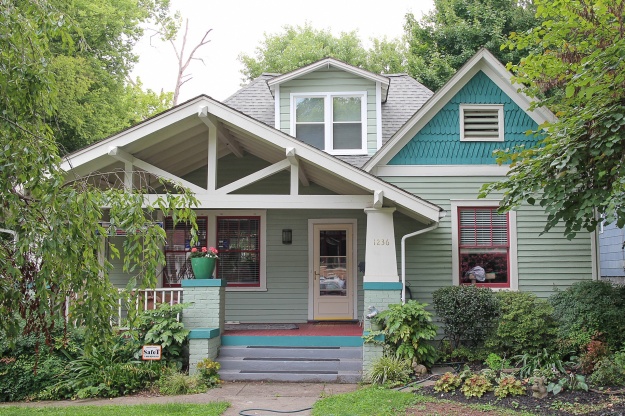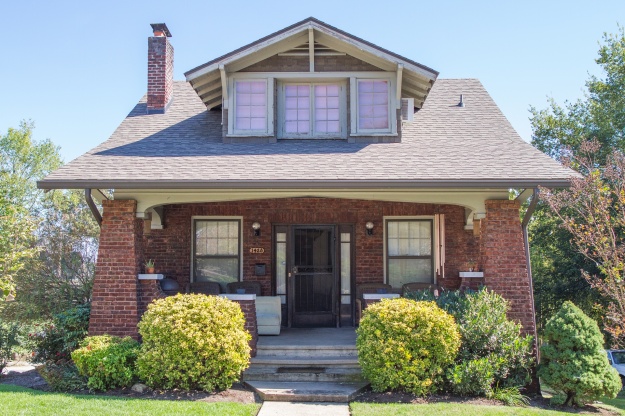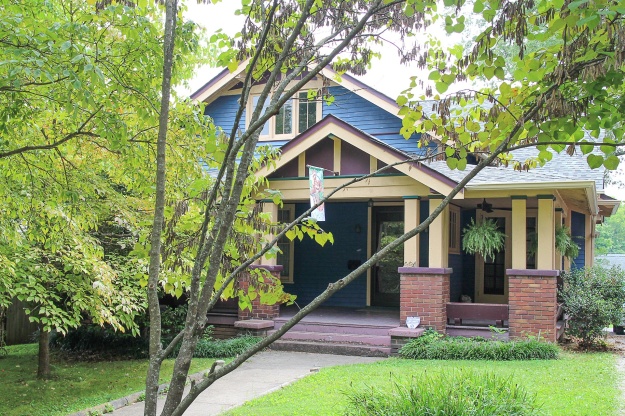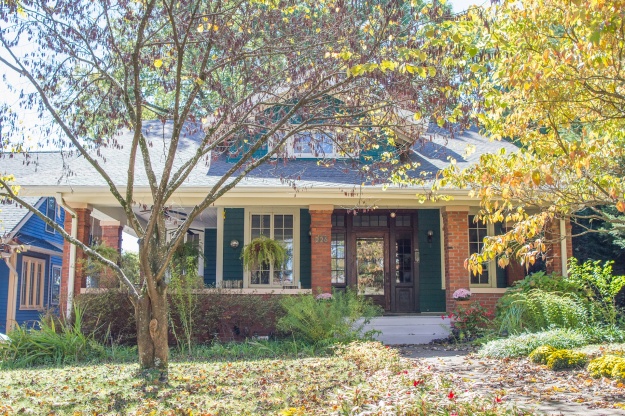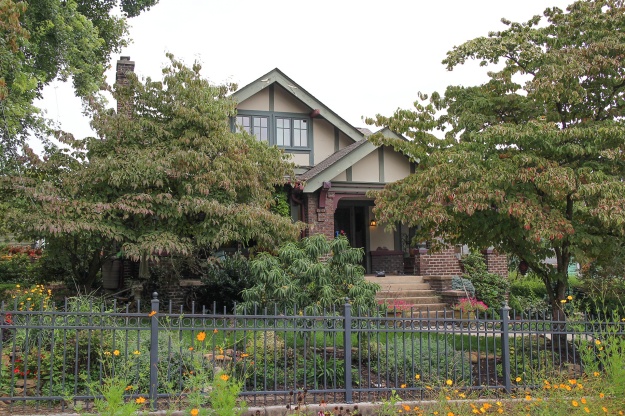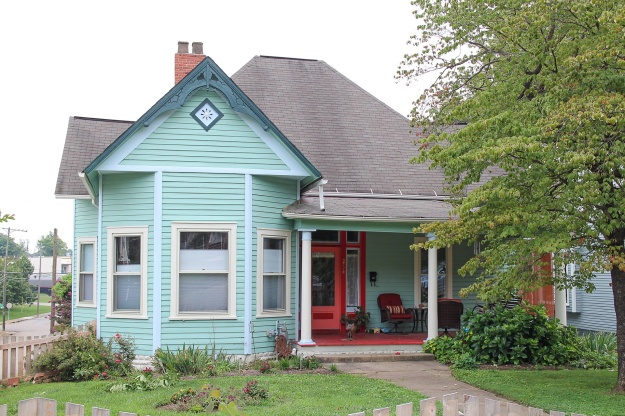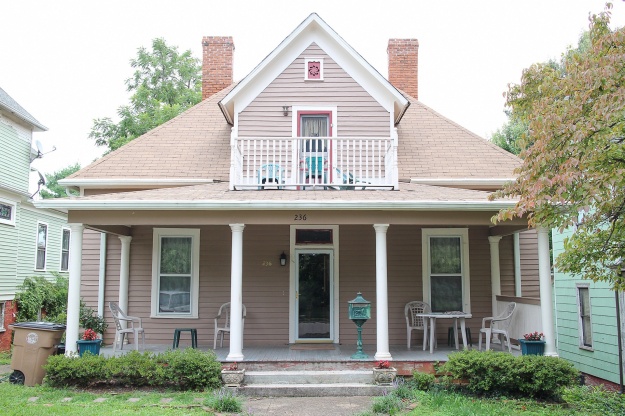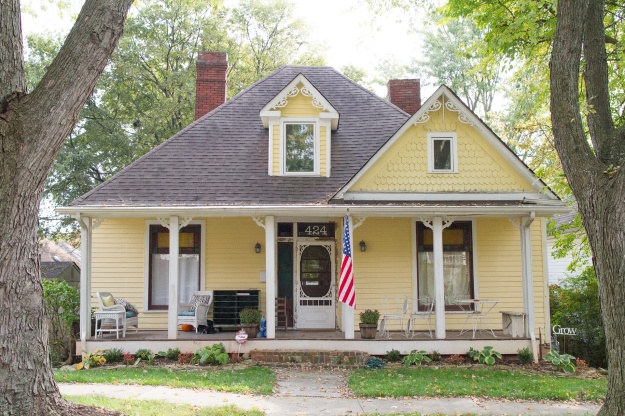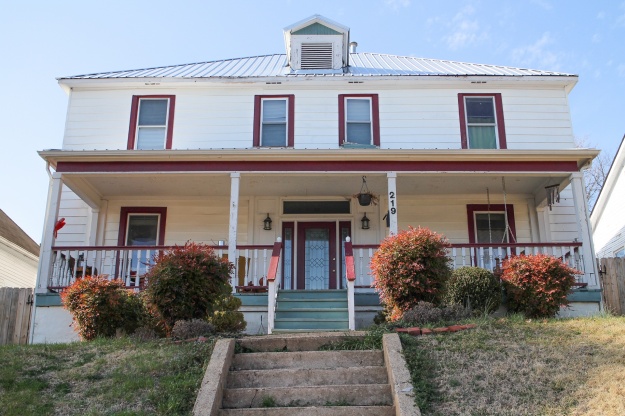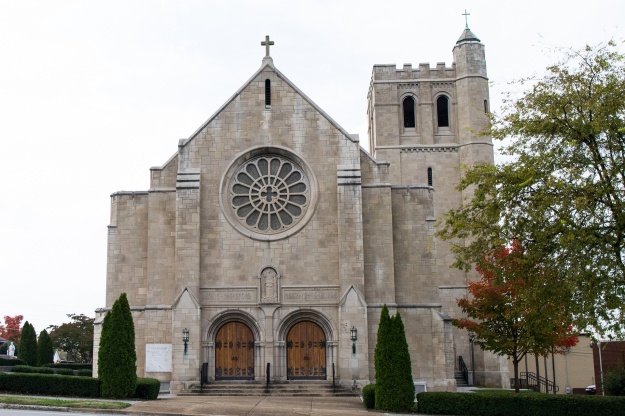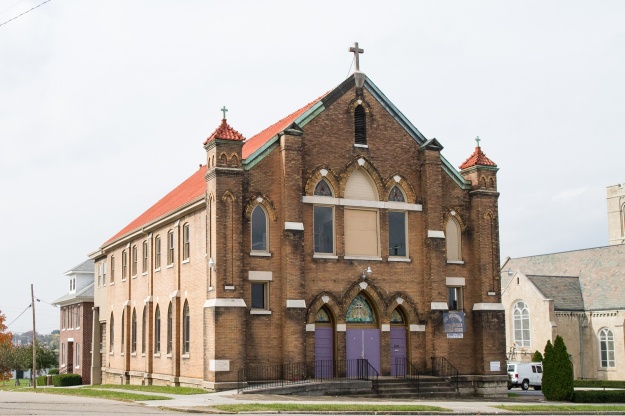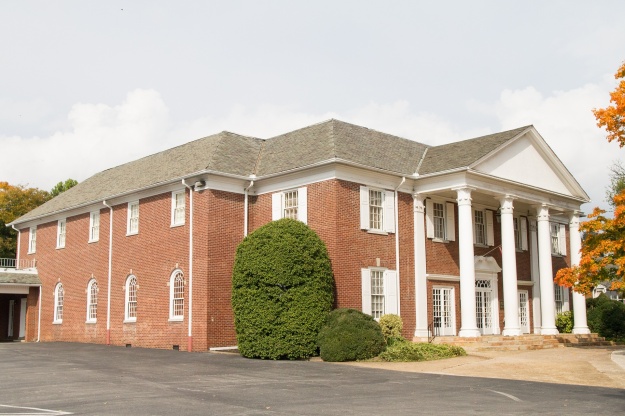1236 Armstrong, Leach-Oates House 1907
The first residents of this house were Mrs. Mattie Leach and her daughter May. They were followed by William H. Davidson, a machinist, in 1909. In 1921, it became home to the family of John T. and Louise Cain Oates. John, an agent for New York Life Insurance Co., died in the early part of the 1940s. Louise was a teacher at nearby Brownlow School for more than 30 years. After retirement, she remained in her family home until her death in 1953.
Architectural tastes change over time, and rarely as drastically as they did during the first two decades of the twentieth century. Many of the older houses in this neighborhood were updated through this period. The narrow, steeper gable on the right, then, with its decorative fishscale shingles and narrow bargeboards, is representative of the late Queen Anne period during which the house was built. The front porch, however, with its lower-pitched roof, forward-facing gable, open-framed truss and rafters, and fat elephantine columns, fits decidedly into the Craftsman period, most likely dating to soon after the house was purchased by the John and Louise Oates.
1428 Fremont, Muir House 1926
A relative latecomer to Old North Knoxville, this house was built in 1925 and 1926 by Arthur and Jewell Muir. Arthur was a district agent for Curtis Publishing Company. Though it appears small from the street, it’s hard not to be charmed. Battered brick porch columns support delicately projected, gently arched beams. The wide front porch welcomes you to the symmetrically-located front door. Multi-paned windows, repetitive exposed rafter tails, and the articulated face of the central dormer all lend a fine grain to the surface details of the exterior.
For the Muirs, unfortunately, timing was not in their favor – they lost the house in the wake of the Wall Street Crash of 1929. Later residents were renters — including William J. Kappes, a paving contractor, and his wife Mignonette, and during WWII, John L. and Grace Griffin. John worked for “Clinton Engineering Works,” the U.S. Army’s euphemistic name for the Manhattan Project.
224 Glenwood, Carmichael House 1917
This house was built in 1917 by Clarence L. and Alice W. Carmichael. Sharing many similarities with its neighboring Craftsman counterparts, unique features to this home include the cross-patterned windows and doors. The interior features ten-foot ceilings, six inch crown moulding, oak hardwood floors, built-in bookcases and cabinets, and period ceiling and wall coverings. The brilliant colors emphasize these features. The exterior of the house has a one-story wraparound front porch with wood posts in double and triple arrangement on brick piers, emphasizing its horizontality.
Clarence Carmichael formed Chandler & Co. building materials with S.V. Chandler in 1908. In 1924, he founded Southern Cast Stone Co., which operated until recently on Sutherland Avenue. After 1930, Clarence and Alice left North Knoxville for a new home they had built on Lyons View Pike.
The present owner has several nice antique pieces throughout the house, including a magnificent six foot mahogany grand piano that was built the same year as the house.
226 Glenwood, Rose Keller Johnson House 1916
This Craftsman-style house was built by J. Alvin Johnson, an attorney, and his wife Rose Keller Johnson. Its architecture emphasizes structural elements, with exposed rafters supported on projecting brackets. The heaviness of the brick porch columns are in direct contrast to the delicate turnings and elaborate spindlework seen on Victorian houses from just a couple of decades earlier. Large casement windows and the wrap-around front and side porch integrate the interior with the outdoors. The divided light transom and sidelights at the front entry also epitomize the style’s reaction against the often dark and insular architecture of its predecessors, while concurrently lending an air of elegance to the simple and honest architecture.
The 1932 City Directory lists J. Alvin and Rose living at this house, but on the 25th of July, he married Elizabeth Guthrie and moved into the Andrew Johnson Hotel. Rose left later that year for a trip to Europe. She returned to this house, and remained here until her death in 1938. A curious historical tidbit is that Rose Keller’s father Thomas was a first cousin of Helen Keller. From 1939 until 1976, the house was home to Mrs. Beulah R. Duff, a widow, whose husband W. Joseph had been a conductor for Southern Railway.
The current owners have lovingly brought the house back to its original glory after discovering Old North Knoxville in 1999. Most recently, a re-shingling project brought on by the 2012 hailstorm escalated into a major restoration of the home’s roof, eaves, and front dormer decorative beams.
1200 Kenyon, Cruze-Mabry House 1914
This Craftsman bungalow has been a fixture in Old North Knoxville since it was built in 1914 by Christopher Columbus Cruze. Typical of the style, its low-pitched roof hugs the ground. Exposed roof rafters, wide eaves, and decorative beams and brackets emphasize the house’s solidity; the large front porch, with its triple corner columns on clinker brick piers, emphasizes its horizontal lines. Most likely, the original bronze hardware, slag glass chandeliers and wall sconces came from one of C.C. Cruze’s hardware businesses. The spacious interior retains many other original features, such as the fumed oak woodwork and ceiling beams, fireplace tile (possibly Grueby) and bath.
C.C. Cruze rode the first streetcar to be operated in Knoxville, drawn by mules along Gay Street. A history buff, he spent much of his free time at the old Lawson McGhee Library studying Knoxville history. When he died in 1937, Ben Morton was a pallbearer. C.C.’s wife Helena, a native of Sheffield, England, died in the family home in 1932.
In 1940, the house was sold to W. Rogers Mabry and his wife Gertrude; they occupied the house for over 30 years. Rogers Mabry, a grandson of Gen. Joseph A. Mabry who built Mabry-Hazen House east of downtown, was merchandise manager for shoes at Miller’s department store.
The 1990s brought a complete renovation to the second story using oak flooring and heart pine woodwork salvaged from a 1910 bungalow in Lyons View. The current owner has updated two bathrooms, which were later additions to the home, as well as the kitchen and laundry.
254 Oklahoma, Kyker House 1907
This Queen Anne cottage was built by James E. Kyker and his wife Lyda, whose great-granddaughter currently lives a block away. Through the years, James Kyker served in a number of different jobs for Southern Railway – engineer, car repairman, hose repairman. Railroads were integral to the economy of turn-of-the-century Knoxville, and many of the houses in North Knoxville were occupied by families with ties to either Southern or L&N Railways.
Note the decorative bargeboard trim and vent in the front gable. Though certainly not as elaborate as some of its larger neighbors, even smaller Victorian houses were given a bit of style. Early deed restrictions, limiting only one house on this lot, insured the deep backyard by prohibiting another house facing the side street as often seen on corner lots.
The rear of this house has undergone extensive renovation in the past year – a lofted ceiling, a curved staircase down to the garage, and built-in cabinets and shelving. The original outswinging garage doors were restored and automated. The kitchen features new custom cabinets and concrete countertops.
236 Scott, West-Evans House 1906
Alice Dean West bought this vacant lot in 1905 for $650. The house was completed in 1906 for Alice and her husband Thomas, an East Tennessee Lath Co. employee. In 1909, they sold the house to John W. Hall, who in turn sold it in 1911 to a widow, Mrs. Mary B. Evans, who lived here with her five children. Her daughter, Annie Lucille, never married, and remained in the house until her death in 1970. Miss Lucille Evans graduated from Knoxville High School in 1914, earned a Bachelor of Arts Degree from UT in 1918, and a Master’s Degree from Columbia University in 1928. She was a teacher at Knoxville High School from 1918 until it was closed in 1951. Until 1966, she taught algebra and Latin at West High School.
Claude Crawford bought the house in 1972, and started the practice of renting rooms. Vaughn Nave, the present owner, bought the house in 1984 and received a Knox Heritage Fantastic Fifteen Award in 2012 for interior and exterior renovations. Dating from late in the Queen Anne period, obvious Victorian elements are limited to the steep roof shapes and the decorative attic vent in the front gable.
424 Oklahoma, Russell Lodging House 1911
Historically, many larger houses in North Knoxville were divided repeatedly into greater numbers of rental units following the Great Depression or during the housing shortage around WWII. Smaller houses, on the other hand, often remained undivided and may have been owner occupied or used as rental housing.
All records seem to indicate that this Queen Anne Cottage was purpose-built to be leased. Completed in 1911 by John D. and Mary T. Russell, the first resident was Elijah T. NcNew, a blacksmith on Central Street. At least four other residents followed before the house was sold in 1920 to Leroy French, a machinist at Brookside Mills, and his wife Nola. In 1922 it was again sold, this time to Allie Mounger, who lived here with her husband William only a couple of years before also deciding to use it as a rental property. The current owner bought the house from a member of the Mounger family in 2006. An upstairs master suite was completed in 2011, giving the house a total of three bedrooms and two baths.
219 Anderson, McGinley House 1910
The Neoclassical style of this house is illustrative of the period of transition between ornate Victorian styles and later Craftsman design. From the street, you may notice that the house is exactly symmetrical. While this may appear to be simply a classical design feature, it is, in actuality, a remnant of the fact that the entire structure was originally a pair of mirrored townhouses, split down the middle. Pay attention on the interior to other clues to the original layout of the two houses, such as the now-double-width stair down the center.
From 1910 to 1913, Mrs. Ella McGinley, widow of Richard McGinley, an engineer with the Southern Railway, owned and lived in half of this duplex. In addition to her daughters Agnes and Pauline, they shared the space with a young boarder and rented the other side of the duplex to Chester R. Hackney, wife Nola Hackney and daughter Ella. Chester’s parents lived next door at what is now 219 E. Anderson Ave.
The duplex changed hands many times from 1914 to 2006, even spending some time divided into four apartments. Renovations in 2006 converted the structure to a single family house as it is today.
1041 Central – Holy Ghost Catholic Church
Holy Ghost Parish was founded in 1907 as Knoxville’s second Catholic parish. Father James Lorigan was named the first pastor. A church was built and dedicated in 1908. That building now houses the Byzantine Ruthenian Catholic Mission of The Holy Resurrection.
Sited just north and downhill of the old church and flanked by a massive bell tower, Holy Ghost Church dwarfs its predecessor. The church is built in the Norman Gothic fashion and done in the style of a cathedral likely to be found in Europe. The church was dedicated in 1926.
One of the most spectacular features of Holy Ghost Church are its stained glass windows. The windows along the walls represent Saints and events in the life of Christ including the Annunciation, the Baptism of Jesus, the Transfiguration and Pentecost. The Holy Ghost window above the main altar and the Rose window above the choir loft are purely decorative. Another beautiful feature is the carved wood reredos behind the Main Altar showing Christ the King and the four Evangelists.
1031 Central – Holy Ghost Catholic Church
From 1908 to 1926, this building served as Holy Ghost Church. After 1926, with the dedication of the larger church to the north, it became universally known as “Old Holy Ghost.” Along with serving as a church, the building was also home to Holy Ghost School which occupied the second floor. Holy Ghost School was open from 1908 to 1963 when it relocated to Fountain City as St. Joseph School. After 1963, the old church served as the thrift store for the Ladies of Charity which moved to a larger building in 2011.
The first pastor, Father James Lorigan, wrote this description of the building in 1909, “The church itself is built of buff colored pressed brick with marble trimmings. The foundation and basement are of solid concrete. The roof is Spanish red tile.” Traces of the original stained glass windows are still visible.
Today it is home to a thriving community of Byzantine Catholics and bears the name The Byzantine Ruthenian Catholic Mission of the Holy Resurrection.
1421 Broadway – Rose Mortuary 1880/1946
Founded in 1932 by Frank L. Rose, the funeral home was originally located on the first floor of the Rose home at Grainger and N. Fourth Avenue. In 1935, the Rose family moved the business to its current location, having purchased a 55 year old two story clapboard house from Mrs. Eleanor McReynolds, wife of Dr. R.L. McReynolds. Built in 1880 by Lute White and her husband William O. White. From 1907 until 1919, it was home to the family of Ben Morton, president of H.T. Hackney Co., Mayor of Knoxville, and one of the instrumental figures in the creation of Great Smoky Mountains National Park.
In 1946 the house was completely remodeled, and the colonial brick front and columns were added. The original staircase and foyer can be found within the present structure, along with much of the original crown moulding. In 1956, an addition, now known as the Garden Wing, was made to the north end of the building, creating a central courtyard with a rose garden and St. Francis fountain.
One of Knoxville’s oldest businesses in continuous operation, Rose Mortuary remains independently owned and operated.

